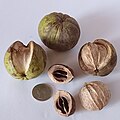Carya laciniosa
Carya laciniosa, commonly known as the shellbark hickory, kingnut hickory, or big shellbark, is a species of hickory native to the eastern United States and southeastern Canada. Its natural habitat extends from western New York to southern Ontario, and as far south as Georgia and as far west as Kansas. This deciduous tree is valued for its large size, distinctive bark, and valuable nuts.
Description[edit]
Carya laciniosa is a large deciduous tree, reaching heights of 60 to 80 feet, and occasionally up to 120 feet. It has a straight, tall trunk and a broad, rounded crown. The bark is its most distinguishing feature, being very thick, dark gray, and deeply furrowed, peeling off in large strips. The leaves are compound, typically with 5-9 leaflets, each 4-7 inches long, with a finely toothed margin. The tree produces male and female flowers on the same plant (monoecious). Male flowers are in drooping catkins; female flowers are short spikes. The fruit is a large nut, 1.5 to 2 inches long, enclosed in a thick husk that splits open in four sections.
Ecology[edit]
The shellbark hickory prefers moist soils along rivers and in mixed hardwood forests. It is a slow-growing tree but can live for several centuries. The nuts are an important food source for wildlife, including squirrels, turkeys, and ducks. The tree also provides habitat for various bird species. Carya laciniosa plays a significant role in its ecosystem, contributing to the biodiversity of the forest understory.
Uses[edit]
Historically, the wood of Carya laciniosa has been used for tool handles, furniture, and flooring due to its strength and durability. The nuts are edible and have been harvested for consumption and oil extraction. They are larger and have a thicker shell than those of other hickory species, which is why the tree is also called the kingnut hickory. In landscaping, the shellbark hickory is planted for its shade and ornamental value, although its large size and slow growth rate make it less common in urban areas.
Conservation[edit]
While not currently listed as endangered, Carya laciniosa faces threats from habitat loss due to land development and agriculture. Conservation efforts focus on protecting natural habitats and promoting the planting of shellbark hickory in suitable locations. Its presence in mixed hardwood forests is essential for maintaining ecological balance and biodiversity.
See Also[edit]
-
Carya laciniosa
-
Carya laciniosa
-
Carya laciniosa
-
Carya laciniosa
-
Carya laciniosa
-
Carya laciniosa
-
Carya laciniosa
-
Carya laciniosa
-
Carya laciniosa
-
Carya laciniosa
-
Carya laciniosa
Ad. Transform your life with W8MD's Budget GLP-1 injections from $75


W8MD offers a medical weight loss program to lose weight in Philadelphia. Our physician-supervised medical weight loss provides:
- Weight loss injections in NYC (generic and brand names):
- Zepbound / Mounjaro, Wegovy / Ozempic, Saxenda
- Most insurances accepted or discounted self-pay rates. We will obtain insurance prior authorizations if needed.
- Generic GLP1 weight loss injections from $75 for the starting dose.
- Also offer prescription weight loss medications including Phentermine, Qsymia, Diethylpropion, Contrave etc.
NYC weight loss doctor appointmentsNYC weight loss doctor appointments
Start your NYC weight loss journey today at our NYC medical weight loss and Philadelphia medical weight loss clinics.
- Call 718-946-5500 to lose weight in NYC or for medical weight loss in Philadelphia 215-676-2334.
- Tags:NYC medical weight loss, Philadelphia lose weight Zepbound NYC, Budget GLP1 weight loss injections, Wegovy Philadelphia, Wegovy NYC, Philadelphia medical weight loss, Brookly weight loss and Wegovy NYC
|
WikiMD's Wellness Encyclopedia |
| Let Food Be Thy Medicine Medicine Thy Food - Hippocrates |
Medical Disclaimer: WikiMD is not a substitute for professional medical advice. The information on WikiMD is provided as an information resource only, may be incorrect, outdated or misleading, and is not to be used or relied on for any diagnostic or treatment purposes. Please consult your health care provider before making any healthcare decisions or for guidance about a specific medical condition. WikiMD expressly disclaims responsibility, and shall have no liability, for any damages, loss, injury, or liability whatsoever suffered as a result of your reliance on the information contained in this site. By visiting this site you agree to the foregoing terms and conditions, which may from time to time be changed or supplemented by WikiMD. If you do not agree to the foregoing terms and conditions, you should not enter or use this site. See full disclaimer.
Credits:Most images are courtesy of Wikimedia commons, and templates, categories Wikipedia, licensed under CC BY SA or similar.
Translate this page: - East Asian
中文,
日本,
한국어,
South Asian
हिन्दी,
தமிழ்,
తెలుగు,
Urdu,
ಕನ್ನಡ,
Southeast Asian
Indonesian,
Vietnamese,
Thai,
မြန်မာဘာသာ,
বাংলা
European
español,
Deutsch,
français,
Greek,
português do Brasil,
polski,
română,
русский,
Nederlands,
norsk,
svenska,
suomi,
Italian
Middle Eastern & African
عربى,
Turkish,
Persian,
Hebrew,
Afrikaans,
isiZulu,
Kiswahili,
Other
Bulgarian,
Hungarian,
Czech,
Swedish,
മലയാളം,
मराठी,
ਪੰਜਾਬੀ,
ગુજરાતી,
Portuguese,
Ukrainian











